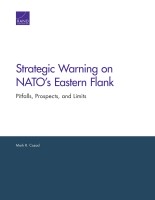| 来源类型 | Research Reports
|
| 规范类型 | 报告
|
| DOI | https://doi.org/10.7249/RR2080
|
| ISBN | 9780833098900
|
| 来源ID | RR-2080-AF
|
| Strategic Warning on NATO's Eastern Flank: Pitfalls, Prospects, and Limits |
| Mark R. Cozad
|
| 发表日期 | 2018
|
| 出版年 | 2018
|
| 页码 | 72
|
| 语种 | 英语
|
| 结论 |
Challenges to Providing Timely Warning of Russian Aggression and Ways to Meet Those Challenges- Russian military forces are in the midst of a major modernization effort, and the demand for intelligence on Russia continues to grow at a pace unparalleled since the end of the Cold War.
- Russia's emergence as a national security priority presents new challenges to meet planning and policy requirements throughout the U.S. government.
- Achieving timely warning has proven extremely difficult, largely because of a lack of insight into Russian leadership intentions.
- Actions necessary for warning frequently do not conform to immediate needs.
- It is unclear whether additional warning time would have allowed policymakers to develop better, more-effective policy options in many Soviet and Russian events.
- It is necessary to ensure that warning indicators, both military and nonmilitary, have diagnostic value and are related to some critical function in the peace-to-war transition.
- Strategies for collecting new indicators of Russian intent will require detailed analysis of activity patterns, technical parameters, and systemic relationships, which in turn will require an understanding of objectives and tasking.
- Nonmilitary exercises could indicate essential wartime functions focused on ensuring internal stability and supporting key mobilization processes and could also provide information on important civil-defense and disaster-preparedness functions.
- Failure to address the fundamental area of denial and deception can lead to additional challenges to the IC's already stressed warning capabilities.
- In areas where there is an already overwhelming Russian advantage, bolstering U.S. and NATO posture will remain the best option for deterring future Russian aggression in the Baltics.
|
| 摘要 |
- To support improvements in warning, research should be focused on immediate issues that will illuminate key problems that Russian political and military leaders believe they will have to address in a crisis or wartime situation.
- Renewed emphasis must be placed on rebuilding expertise on Russia, improving collection and analysis capabilities, and emphasizing key elements of analytic tradecraft that might improve warning.
- Analytic effort should be dedicated to research to improve the IC's current indicators, develop better understanding of key civil-military processes and functions necessary for transitioning to war, and rebuild the experience and expertise on Russia the IC has lost over the past two decades.
|
| 主题 | Military Intelligence
; North Atlantic Treaty Organization
; Russia
; Soviet Union
; Ukraine
; United States
|
| URL | https://www.rand.org/pubs/research_reports/RR2080.html
|
| 来源智库 | RAND Corporation (United States)
|
| 引用统计 |
|
| 资源类型 | 智库出版物
|
| 条目标识符 | http://119.78.100.153/handle/2XGU8XDN/108734
|
推荐引用方式
GB/T 7714 |
Mark R. Cozad. Strategic Warning on NATO's Eastern Flank: Pitfalls, Prospects, and Limits. 2018.
|
|
文件名:
|
x1520427901418.jpg
|
|
格式:
|
JPEG
|

|
文件名:
|
RAND_RR2080.pdf
|
|
格式:
|
Adobe PDF
|
除非特别说明,本系统中所有内容都受版权保护,并保留所有权利。